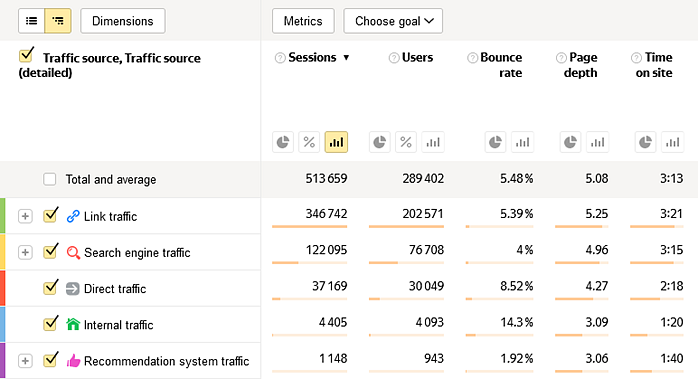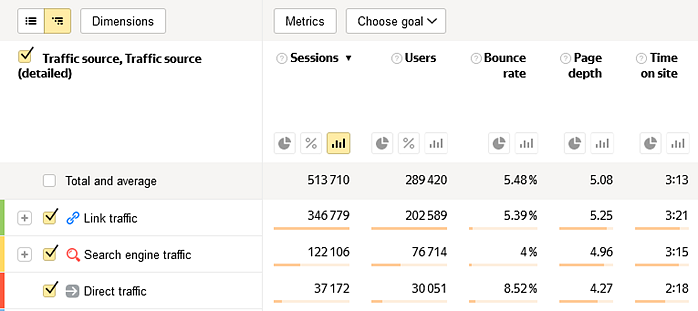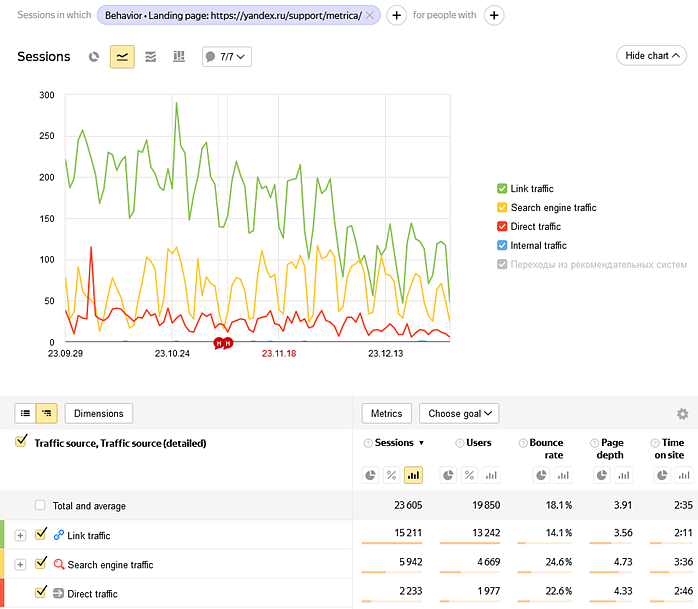“Sources, Summary” report
The summary report contains information on all the sources that attracted users to your website.
To view the report: .
An example of this report is available for the Yandex Metrica demo tag.
Ways to use this report
- The user typed your site URL in the browser's address bar.
- The user opened your site from their browser bookmarks.
- The user clicked a link added to site tiles in a new browser tab (for example, in Yandex Browser).
- The user transitioned from a site that uses the HTTPS protocol to a site with the HTTP protocol.
- The traffic source was not transmitted to the referrer.
- The user opened your website by clicking a locally saved link (the session might have the referrer file:///С:/Documents/User/page.html).
- The landing page domain contains localhost or 127.
- The user typed your site URL in the browser's address bar.
- The user opened your site from their browser bookmarks.
- The user clicked a link added to site tiles in a new browser tab (for example, in Yandex Browser).
- The user transitioned from a site that uses the HTTPS protocol to a site with the HTTP protocol.
- The traffic source was not transmitted to the referrer.
- The user opened your website by clicking a locally saved link (the session might have the referrer file:///С:/Documents/User/page.html).
- The landing page domain contains localhost or 127.
- Find the for people with condition group and click
 .
. - Select the condition .
- Select More, Less, or Equals and enter the amount.
- Click the Metrics button.
- Select Average revenue from purchase.
- Find the Sessions that condition group and click
 .
. - Select the condition .
- Specify the webpage URL.
The report shows the sources that attracted users to your website.

The percentage of the following traffic sources may indicate that users are familiar with your site:
| Source | Description |
|---|---|
| Direct traffic | Yandex Metrica attributes traffic to this source in the following cases: |
| Cached page traffic | Yandex Metrica attributes traffic to this source in the following cases: |
| Source | Description |
|---|---|
| Direct traffic | Yandex Metrica attributes traffic to this source in the following cases: |
| Cached page traffic | Yandex Metrica attributes traffic to this source in the following cases: |
The higher the bounce rate, the less the site is engaging users (bounces are users who leave within 15 seconds of looking at a single page). For instance, a high bounce rate for search engine clicks may indicate that your web pages are not relevant to users' search queries. For more information, see the Search queries report.




To do this, select the segment with the URL of the specific page:

Report structure and settings
Each session has its own source. Yandex Metrica organizes the sources into groups:
| Source | Description |
|---|---|
| Direct traffic | Yandex Metrica attributes traffic to this source in the following cases:
|
| Link traffic | Users visited your site by clicking a link on another site. The page URL hosting the link is saved as the referrer. |
| Search engine traffic | Users clicked a link to your site in search results. Yandex Metrica can detect the majority of search engines. Yandex Metrica stores the name of the search engine used, usually along with the search query. |
| Traffic from social networks | Users followed a link posted on a social network. Most social networks identify the user who posted a link or the community it was posted by. |
| Ad traffic | Traffic generated by Yandex services (Yandex Direct, Yandex Market), media platforms, and tagged links (such as UTM, Openstat, or Google Ads). For more information, see the Ad systems report. |
| Messenger traffic | Clicks on links posted in messengers are identified by the referrer and UTM tags.
Details Yandex Metrica collects data on the following messengers: Use these UTM tags to identify your source of traffic: |
| Recommendation system traffic | Clicks on links in news feeds, personalized recommendation lists, and similar sources. Does not include data from traffic exchange networks and news aggregators (News, Rambler News and Google News).
Details Yandex Metrica recognizes the following recommendation systems: |
| Cached page traffic | Yandex Metrica attributes traffic to this source in the following cases:
|
| Internal traffic | If the user stopped doing anything on the site and the session timeout expired but the browser was still open, when the user later resumes activity Yandex Metrica registers a new session with “internal traffic” as the source. Note. For accurate detection of internal traffic, make sure that the correct site URL is shown in the tag settings (in the Tag section). |
| Mailing traffic | The user clicked a link in an email. This includes:
For more information, see How to correctly create a tag. |
| Click-throughs via QR codes | Traffic to the site via QR codes is detected using UTM tags. For more information, see How to correctly create a tag. |
| Undefined | Undefined means that some of the session characteristics couldn't be identified, although the session itself was registered in the system. For instance, Yandex Direct traffic may have Yandex Direct: Undefined listed as the source. That means that Yandex Metrica recognized the ad platform, but couldn't identify details such as the campaign, keyword, and so on.
|
| Source | Description |
|---|---|
| Direct traffic | Yandex Metrica attributes traffic to this source in the following cases:
|
| Link traffic | Users visited your site by clicking a link on another site. The page URL hosting the link is saved as the referrer. |
| Search engine traffic | Users clicked a link to your site in search results. Yandex Metrica can detect the majority of search engines. Yandex Metrica stores the name of the search engine used, usually along with the search query. |
| Traffic from social networks | Users followed a link posted on a social network. Most social networks identify the user who posted a link or the community it was posted by. |
| Ad traffic | Traffic generated by Yandex services (Yandex Direct, Yandex Market), media platforms, and tagged links (such as UTM, Openstat, or Google Ads). For more information, see the Ad systems report. |
| Messenger traffic | Clicks on links posted in messengers are identified by the referrer and UTM tags.
Details Yandex Metrica collects data on the following messengers: Use these UTM tags to identify your source of traffic: |
| Recommendation system traffic | Clicks on links in news feeds, personalized recommendation lists, and similar sources. Does not include data from traffic exchange networks and news aggregators (News, Rambler News and Google News).
Details Yandex Metrica recognizes the following recommendation systems: |
| Cached page traffic | Yandex Metrica attributes traffic to this source in the following cases:
|
| Internal traffic | If the user stopped doing anything on the site and the session timeout expired but the browser was still open, when the user later resumes activity Yandex Metrica registers a new session with “internal traffic” as the source. Note. For accurate detection of internal traffic, make sure that the correct site URL is shown in the tag settings (in the Tag section). |
| Mailing traffic | The user clicked a link in an email. This includes:
For more information, see How to correctly create a tag. |
| Click-throughs via QR codes | Traffic to the site via QR codes is detected using UTM tags. For more information, see How to correctly create a tag. |
| Undefined | Undefined means that some of the session characteristics couldn't be identified, although the session itself was registered in the system. For instance, Yandex Direct traffic may have Yandex Direct: Undefined listed as the source. That means that Yandex Metrica recognized the ad platform, but couldn't identify details such as the campaign, keyword, and so on.
|
The report supports all settings available in Yandex Metrica.